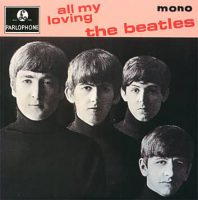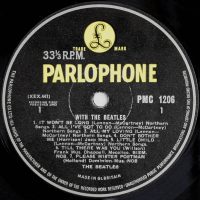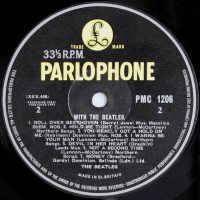Studio Two, EMI Studios, Abbey Road
Producer: George Martin
Engineer: Norman Smith
This was The Beatles’ second EMI session of the day; the first had ended so the group could record an interview and radio session for the BBC. The evening session began at 5pm and finished at 11pm, an hour later than scheduled.
The first song to be worked on was ‘Money (That’s What I Want)’. The Beatles had recorded the song during the 18 July session, but today saw George Martin overdub the piano chords in seven takes.
‘Till There Was You’ was another song begun on 18 July. The Beatles today recorded takes 4-8, the last of which was the best.
Five takes of ‘Roll Over Beethoven’ followed, with George Harrison on lead vocals. The group then recorded two overdubs, only one of which was used, and an edit piece of the final guitar chord.
‘It Won’t Be Long’ was completed next, following the morning’s unsatisfactory attempts to capture it on tape. The Beatles recorded seven more takes (numbered 11-17) and six edit pieces (18-23). An edit of takes 17 and 21 was made on 21 August 1963 for the album.
The final song to be recorded on this day was Paul McCartney’s ‘All My Loving’. The takes were numbered 1-14, although there was no take five. Of these, the first 11 were run-throughs of the song, and 12-14 were overdubs. The version on With The Beatles was a mix of takes 11 and 14.




I’m hoping folks on this site can help clear up something for me regarding the Beatles’ recording techniques for two-track-tape sessions like this one. According to a free preview from the book Recording The Beatles — https://recordingthebeatles.com/1963ProductionPreview.pdf — it was impossible for EMI equipment in 1963 to erase the contents of one track on a two-track tape without also erasing the contents of the other track. The book states that the recorder used for Beatles sessions in 1963 “was not a true multi-track machine.” (This all changed when they started using four-track recorders.)
For this reason, the Beatles would do overdubs in 1963 by playing back a performance from one session tape while adding new vocals/instruments, sending all of this sound onto a second session tape. This means the overdubs on early Beatles songs do not exist on the same session tape as the original ‘backing track’ performance.
But that description doesn’t fit with the Abbey Road studio documentation for sessions like this one. For Roll Over Beethoven and All My Loving (maybe others recorded this day too), studio documents pictured in Lewisohn’s Beatles Recording Sessions show that overdubs were recorded on the SAME TAPE as the ‘backing track’ performance.
How can this be? Are the authors of Recording the Beatles mistaken? Am I missing something?
As far as I understand they did both and here’s how.
Sometimes they did in fact feed original tracks into another tape recorder while recording a live track(s) at the same time – thus creating effect of either three or four tracks. That’s why their earliest recordings have some elements that sound more muffled while others sound brighter.
The first track that is feed into the second machine loses a generation of quality.
Also, later on however they discovered – and for some reason I think it was Paul who discovered this – that if you remove the erase head from the tape machine you could then record right onto the very tape you’d already recorded on (without the sound degrading).
Also you could record the rhythm section on track one and then re-run the tape through the machine (with the erase head removed) and then record onto track two.
They did find that sometimes they over-saturated the tape itself.
And sometimes they did both methods together.
My guess is that (and I am sure informed people will clarify) for the session you reference they did the first method and used two machines.
When I was a teenager, making mixed tapes on my cassette recorder, I got the idea to lift the wire that powers the erase head. No power, nothing erased.